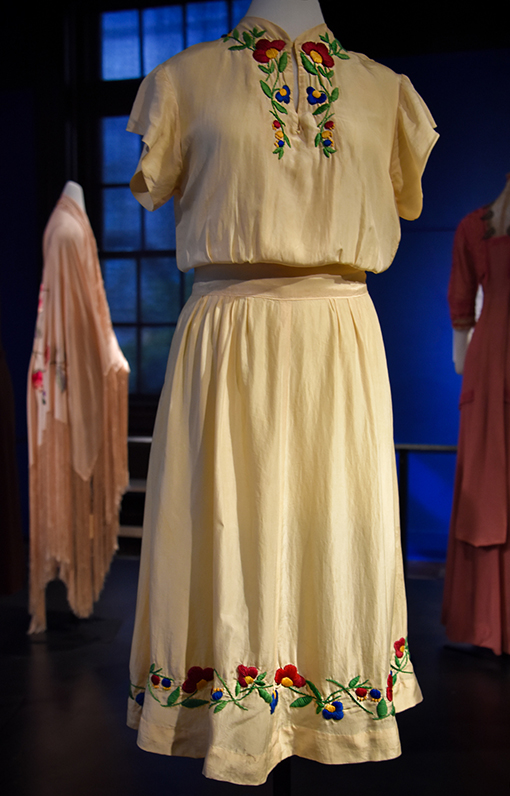Silk & Stitch, a time-traveling fashion exhibition at the DeKalb History Center invites you to explore—through the lens of fashion embellishments—the expanding role of women and the circumstances that influenced women's fashion from 1860s through the 1960s. The exhibition is slated to be up through sometime in July, but the Center is closed until further notice, due to the current pandemic, for the safety of staff and visitors. If the Center reopens before the exhibition has to close, please go see it. You'll see a lot more than what I've shared here.
 |
| Silk & Stitch | DeKalb History Center | Photo: Travis Swann Taylor |
This ivory wedding gown was fabricated in the late 1860s and was modified in the 1880s for another bride.
This exhibition is partly funded through a mannequin "adoption campaign" and the donors who adopted one enjoyed the opportunity to name and dedicate the mannequin!
 | |
|
This is a closer look at the ivory wedding gown, made with silk peau de soie, lace, and net. The adopters of this mannequin named it "Lucia Du Vinage Howard" dedicated to "Dear Dear".
The garments and accessories in Silk & Stitch are from the DeKalb History Center's textile collection, and includes some that are on loan from generous outside sources.
 | |
|
This brown dress is circa 1872-1880 and made of silk faille, glazed cotton lining, and embellished with alternating velvet and jacquard stripes. Adopted by an anonymous sponsor, the mannequin's name is "Martha".
It looks like a Hollywood period film costume, but it was part of someone's actual wardrobe! The workmanship is magnificent.
This blue afternoon dress is circa 1880 and made of silk faille, glazed cotton lining, and embellished with embroidery and decorative buttons.
Imagine perambulating through downtown Decatur in this! You'd certainly catch people's eye, back in 1880 as well as in 2020. Adopted by an anonymous sponsor, this mannequin's name is "Sallie".
This green and orange dress is circa 1890s and is made of silk peau de soie, silm damask, and silk velvet. Adopted by an anonymous sponsor, this mannequin wasn't named. What would you name her?
This is the lower portion of the green and orange dress. The feather stitching on this is stunning, don't you think? Imagine how long it must have taken to do this!
By the way, I'm having to look up a lot of the fashion design words used in this exhibition. I love a great season of Project Runway, but I don't know the lingo. Learning as I write!
This black mourning coat, circa 1890s, is made of silk taffeta and horsehair! It's embellished with soutache, horsehair braids, and has a pleated taffeta border. The adopter named this mannequin "Katie Mathilda".
This yellow tea dress, circa 1890s, is made of silk surah, cotton lining, and a number of embellishments. This mannequin's adopter named her "Marie Rysdon".
Available for private events, the DeKalb History Center would be fantastic for a formal afternoon tea, and of course weddings.
This black evening coat, circa 1900-1910, is made of net with a silk satin lapel and facing. The mannequin's name is "Moppy" and it's dedicated to Martha Darnell.
This pink dress, circa 1912-1914, is made of cotton gauze and has a paragraph of embellishments, which you can see just by looking at it. Someone was at this for quite a long time, I imagine! I would venture to say that the lady who owned this dress had impeccable taste! This mannequin's name is "Ada".
This pink shawl, circa 1920s, is made of silk (perhaps rayon) and is embellished with hand-knotted fringe, hand-embroidered satin stitch and seed stitch.
This exhibition includes accessories—hats and purses—which are not pictured in this post, but are definitely worth the attention of every fashion and history enthusiast. They're stunning!
This brown dress is circa 1930s and is made of rayon crepe, I imagine quite beautiful for a dress made in The Great Depression era—it's beautiful even without that consideration.
It's embellished with hand beaded glass seed beads and faux pearls, prong-set rhinestones, and bound buttonholes. This mannequin's name is "Mary Louise McWilliams Huey".
Unlike the early 1980s parachute pants made of nylon, this circa 1945 parachute dress is made from an actual parachute, which at that time were made of silk! It's embellished with padded satin stitch and stem stitch. Its sponsor named this mannequin "Annie Lou".
Keep an eye on the DeKalb History Center's website and social media for information about seeing this exhibition. If you're local, sign-up for their emails and be the first to know or even consider a membership!











1 comment:
Most people enjoy lots of the chats, My partner and i in fact knowledgeable, I'd personally favor additional information in relation to this kind of, given that it really is great., Together with as a result of acquire dispersing. Style Shop
Post a Comment